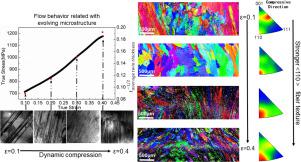当前位置:
X-MOL 学术
›
Mater. Des.
›
论文详情
Our official English website, www.x-mol.net, welcomes your feedback! (Note: you will need to create a separate account there.)
Flow behavior and microstructure evolution during dynamic deformation of 316 L stainless steel fabricated by wire and arc additive manufacturing
Materials & Design ( IF 8.4 ) Pub Date : 2021-01-01 , DOI: 10.1016/j.matdes.2020.109325 Jie Chen , Haiyang Wei , Xianfeng Zhang , Yong Peng , Jian Kong , Kehong Wang
Materials & Design ( IF 8.4 ) Pub Date : 2021-01-01 , DOI: 10.1016/j.matdes.2020.109325 Jie Chen , Haiyang Wei , Xianfeng Zhang , Yong Peng , Jian Kong , Kehong Wang

|
Abstract Additively Manufactured structural components would often serve the impact environment while sufficient efforts have not been paid on their dynamic response. In this study, cold metal transfer wire and arc additive manufacturing (CMT-WAAM) process was used to fabricate 316 L stainless steel and initial well-aligned coarse austenitic columnar crystals with 〈100〉 texture along deposition direction were developed. Samples of as-built 316 L were subjected to dynamic compressions with various strain rates and strains by split hopkinson pressure bar (SHPB). The as-built 316 L dynamically exhibits ~50% higher yield strength and twice elastic modulus than quasi-static condition. Twinning acts as main deformation mode whereas strain induced martensitic transformation has not been found. Microstructure evolution upon progressive strains at similar high strain rates reveals continuously increase in the population of deformation twins associated with a gradual decrease in average twin thickness from 120 nm to 20 nm. Average twin thickness as the key physical parameter from evolving microstructures and flow behavior are well fitted using empirical equation. A careful texture analysis suggests a remarkable transition from initial 〈100〉 ||CD (compression direction) to the component 〈110〉 ||CD. Our findings provide the mechanistic insights into understanding the dynamic behavior of additively manufactured stainless steel.
中文翻译:

线材和电弧增材制造316L不锈钢动态变形过程中的流动行为和微观结构演变
摘要 增材制造的结构构件往往服务于冲击环境,而对其动态响应却没有做出足够的努力。在这项研究中,冷金属传输线和电弧增材制造 (CMT-WAAM) 工艺用于制造 316 L 不锈钢,并开发出沿沉积方向具有 <100> 织构的初始排列良好的粗奥氏体柱状晶体。通过分裂式霍普金森压力棒 (SHPB) 对竣工的 316 L 样品进行各种应变率和应变的动态压缩。与准静态条件相比,竣工的 316 L 动态表现出约 50% 的屈服强度和两倍的弹性模量。孪生是主要的变形模式,而尚未发现应变诱发马氏体相变。在类似的高应变率下,随着渐进应变的显微结构演变表明变形孪晶的数量不断增加,这与平均孪晶厚度从 120 nm 逐渐减小到 20 nm 相关。平均孪晶厚度作为来自不断演变的微观结构和流动行为的关键物理参数,使用经验方程很好地拟合。仔细的纹理分析表明从初始<100> ||CD(压缩方向)到组件<110> ||CD 的显着转变。我们的发现为理解增材制造不锈钢的动态行为提供了机械见解。平均孪晶厚度作为来自不断演变的微观结构和流动行为的关键物理参数,使用经验方程很好地拟合。仔细的纹理分析表明从初始<100> ||CD(压缩方向)到组件<110> ||CD 的显着转变。我们的研究结果为理解增材制造不锈钢的动态行为提供了机械见解。平均孪晶厚度作为来自不断演变的微观结构和流动行为的关键物理参数,使用经验方程很好地拟合。仔细的纹理分析表明从初始<100> ||CD(压缩方向)到组件<110> ||CD 的显着转变。我们的研究结果为理解增材制造不锈钢的动态行为提供了机械见解。
更新日期:2021-01-01
中文翻译:

线材和电弧增材制造316L不锈钢动态变形过程中的流动行为和微观结构演变
摘要 增材制造的结构构件往往服务于冲击环境,而对其动态响应却没有做出足够的努力。在这项研究中,冷金属传输线和电弧增材制造 (CMT-WAAM) 工艺用于制造 316 L 不锈钢,并开发出沿沉积方向具有 <100> 织构的初始排列良好的粗奥氏体柱状晶体。通过分裂式霍普金森压力棒 (SHPB) 对竣工的 316 L 样品进行各种应变率和应变的动态压缩。与准静态条件相比,竣工的 316 L 动态表现出约 50% 的屈服强度和两倍的弹性模量。孪生是主要的变形模式,而尚未发现应变诱发马氏体相变。在类似的高应变率下,随着渐进应变的显微结构演变表明变形孪晶的数量不断增加,这与平均孪晶厚度从 120 nm 逐渐减小到 20 nm 相关。平均孪晶厚度作为来自不断演变的微观结构和流动行为的关键物理参数,使用经验方程很好地拟合。仔细的纹理分析表明从初始<100> ||CD(压缩方向)到组件<110> ||CD 的显着转变。我们的发现为理解增材制造不锈钢的动态行为提供了机械见解。平均孪晶厚度作为来自不断演变的微观结构和流动行为的关键物理参数,使用经验方程很好地拟合。仔细的纹理分析表明从初始<100> ||CD(压缩方向)到组件<110> ||CD 的显着转变。我们的研究结果为理解增材制造不锈钢的动态行为提供了机械见解。平均孪晶厚度作为来自不断演变的微观结构和流动行为的关键物理参数,使用经验方程很好地拟合。仔细的纹理分析表明从初始<100> ||CD(压缩方向)到组件<110> ||CD 的显着转变。我们的研究结果为理解增材制造不锈钢的动态行为提供了机械见解。



























 京公网安备 11010802027423号
京公网安备 11010802027423号